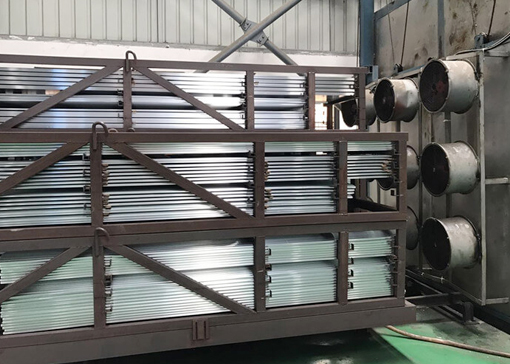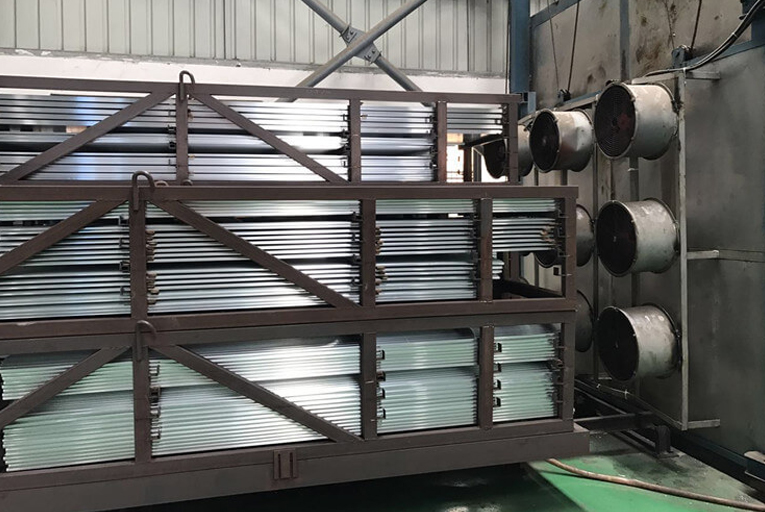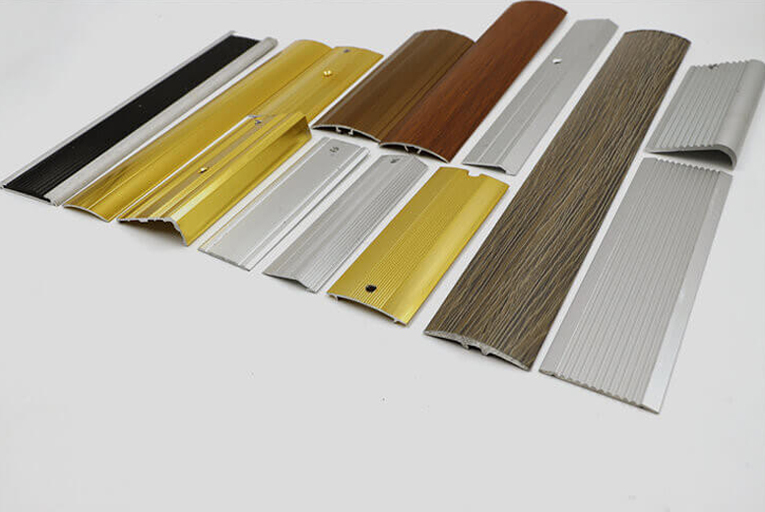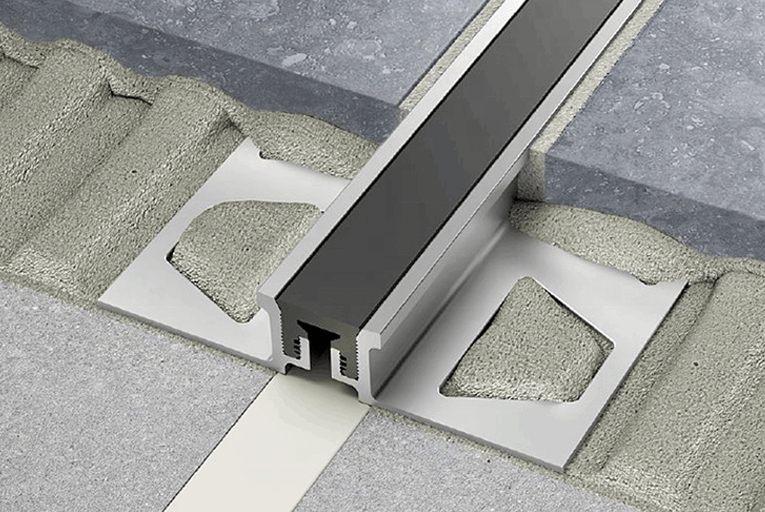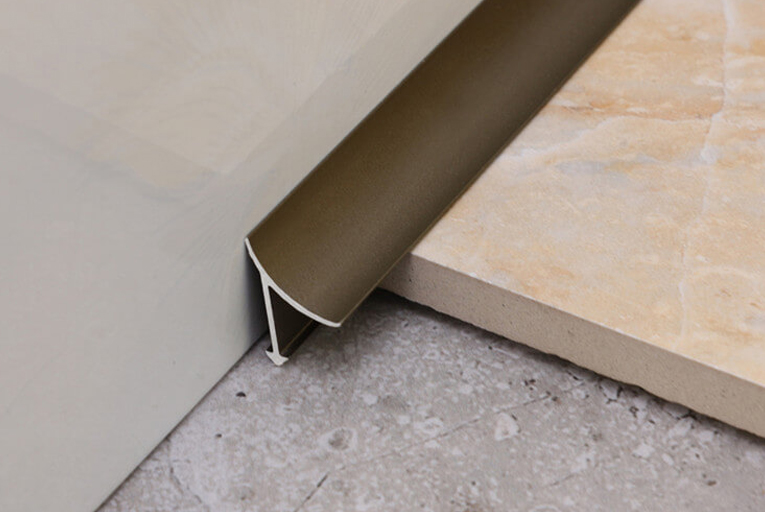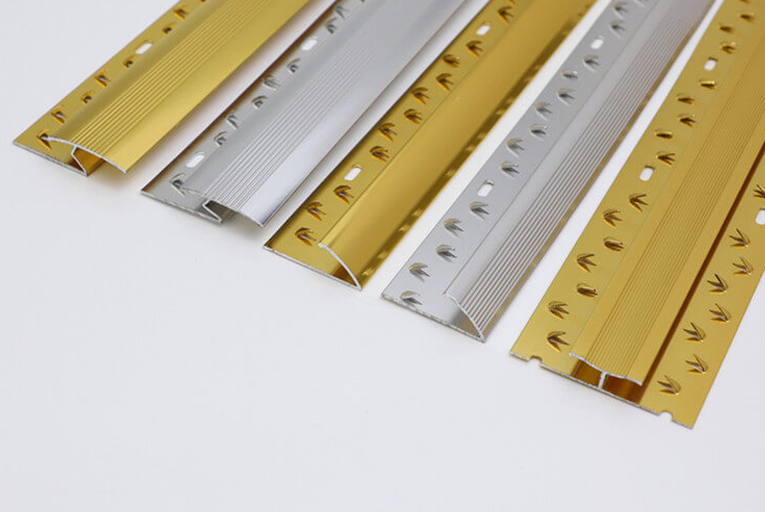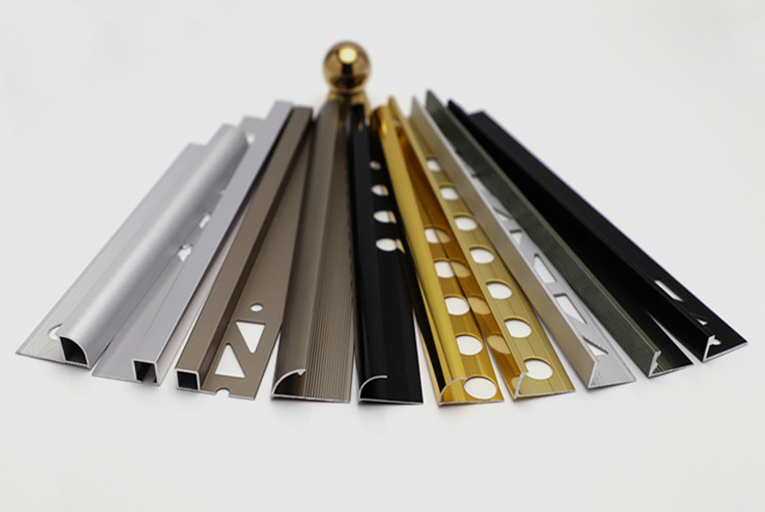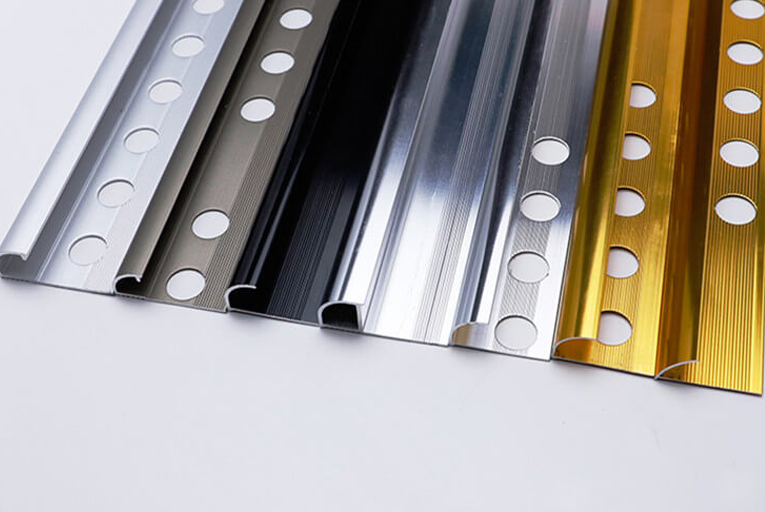Pre-Treatment Process of Aluminum Profile Coating
There are many processes for pretreatment of aluminum profile spraying, which can be selected according to specific conditions, such as plant conditions, i.e. size of space location, surface condition of the workpiece (rust, antirust oil, debris), the material of workpiece (cold-rolled plate, hot-rolled plate, galvanized plate, aluminum alloy, glass steel, etc.), production batch, quality requirements, etc. Different manufacturers use different processes, and the pre-treatment process generally has the following two types.
1. Pre-Treatment of Aluminum Profile Parts
Typical process flow: pre-degreasing → degreasing → washing I → pickling → washing II → neutralization → washing III → table conditioning → phosphating → washing IV → passivation, manufacturers can be adjusted according to the actual situation of the plant.
As the pretreatment of the parts, pickling and rust removal is essential. However, in the pretreatment process, it is best to separate the rusted parts and non-rusted parts, rusted parts for pickling, non-rusted parts are best not to pickle.
2. Product Pre-Treatment
Product pre-treatment is to immerse the whole aluminum profile product into the tank liquid for surface treatment, which has been adopted by many manufacturers at present. There are two kinds of inter-process transfer: manual control and automatic control. More advanced is the use of PLC program automatic control, which can realize the automatic transfer between processes. The general process is: degreasing → washing → table conditioning → phosphating → washing.
The common equipment used for pretreatment of aluminum profile spraying is spraying type combined cleaning machine, whose cleaning principle is to complete the process of degreasing, phosphating, passivation, cleaning, etc. with the help of spraying mechanical force and chemical action.
Spray combined cleaning machine typical processes are: degreasing, washing, table conditioning, phosphating, passivation, water washing, pure water washing.
Its structure is characterized by: pre-treatment production line each process spray pipe arranged in the tunnel, spraying by the pump of each liquid tank to provide. Each process is separated by a doorway plate to prevent the liquid from being tampered with. The heating form of each heating liquid tank is inside and outside the tank. The inner heater has row tube, serpentine tube, corrugated plate, etc.; the outer heater has column tube, plate heater, etc. Heating media are hot water, steam, heat transfer oil, etc. In the degreasing, phosphating process are equipped with oil removal system and slag removal system. In order to prevent the heating section of the top of the tunnel and the doorway at the overflow of steam, there is an exhaust fan at the top of the tunnel.
Each process control elements are divided as follows.
1. Degreasing
The mechanism of degreasing is through the role of saponification, solubilization, wetting, dispersion and emulsification of all kinds of grease by degreasing agent, so that the grease is detached from the surface of the aluminum workpiece and becomes soluble material or is emulsified, dispersed and evenly and stably present in the tank liquid. The evaluation of degreasing quality is mainly based on the standard that there should be no visual grease, emulsion and other dirt on the surface of aluminum profile workpiece after degreasing, and the surface should be completely wetted by water after washing.
The quality of degreasing mainly depends on free alkalinity, temperature of degreasing solution, processing time, mechanical action and oil content of degreasing solution, etc.
(1) Free Alkalinity (FAL)
Proper concentration of degreasing agent is necessary to ensure the best results. Generally only need to test the free alkalinity of the degreasing solution, FAL is too low, the oil removal effect is relatively poor; FAL is too high, not only resulting in material waste, but also to the back of the wash to increase the burden, serious cases will also contaminate the back order of table conditioning and phosphating.
(2) The Temperature of The Degreasing Solution
Any kind of degreasing fluid has the best degreasing temperature, the temperature is lower than the process requirements, can not give full play to degreasing; temperature is too high, not only to increase energy consumption, but also can bring some side effects. Such as degreasing agent evaporates too quickly, the workpiece out of the tank liquid because the surface drying speed is faster, easy to cause aluminum workpiece rust, alkali spots, oxidation and other ills, affecting the quality of phosphating after the process. Automatic temperature control also needs to be regularly calibrated.
(3) Processing Time
Degreasing solution must be in full contact with the oil on the aluminum workpiece, there is enough contact reaction time to ensure a good degreasing effect. However, degreasing time is too long, it will increase the passivity of the surface of the aluminum workpiece, affecting the generation of phosphate film.
(4) The Impact of Mechanical Action
Degreasing process, supplemented by mechanical action, the use of pump circulation or moving aluminum profile workpiece, can strengthen the effect of degreasing, shorten the time of dipping cleaning; spray degreasing speed than dipping degreasing speed of more than 10 times faster.
(5) Degreasing Liquid Oil Content
With the recycling of the tank liquid, the oil content in the tank liquid will keep increasing, and when it reaches a certain proportion, the degreasing effect and cleaning efficiency of the degreasing agent will drop significantly, and even if the high concentration of the tank liquid is maintained by adding chemicals, the cleanliness of the surface of the treated aluminum profile workpiece will not be improved. The degreasing liquid that has aged and deteriorated must be replaced in the whole tank. Product production is generally based on the use time of the tank liquid and the processing workload to change the tank in due course.
2. Pickling
When the steel used for product manufacturing is rolled and formed or stored and transported, rust will occur on the surface. Since the rust layer is loose in structure and not firmly attached to the base material, and the oxide and aluminum iron can form a primary cell, further prompting the corrosion of aluminum, so that the coating is quickly destroyed, so it must be cleaned before painting. The product is generally commonly used is pickling rust removal, which will not deform the aluminum workpiece, every corner of the rust can be removed, the speed of rust removal is fast and the cost is relatively low.
The quality of pickling is mainly based on the standard that there should be no visually visible oxide, rust and over-etching on the pickled workpiece. The factors affecting the effect of rust removal are mainly as follows.
(1) Free Acidity (FA)
Measuring the free acidity FA of pickling tank is the most direct and effective evaluation method to verify the rust removal effect of pickling tank. If the free acidity is low, the rust removal effect is poor. When the free acidity is too high, the acid mist content in the working environment is larger, which is not conducive to labor protection; the aluminum surface is prone to “over-etching”; and it is difficult to clean the residual acid, which will easily lead to the pollution of the subsequent tank solution.
(2) Temperature, Time
Most of the pickling is carried out at room temperature, when using heated pickling, generally controlled between 40 ¡æ ~ 70 ¡æ, although the temperature has a greater impact on the improvement of pickling capacity, but the temperature is too high will intensify the corrosion of aluminum workpieces, equipment, the impact on the working environment is also very unfavorable; and in the premise of completely remove the rust, pickling time should be as short as possible to reduce the corrosion of aluminum and the impact of hydrogen embrittlement. Therefore, the temperature of the tank liquid and the processing time of the aluminum profile workpiece should be strictly controlled during the treatment process.
(3) Pollution Aging
Acid in the process of rust removal, will continue to bring in oil or other impurities, which can be removed by scraping the suspended impurities; when the soluble iron ions exceed a certain content, the rust removal effect of the tank solution will not only greatly reduce, and excess iron ions with the workpiece surface residue mixed into the phosphate tank, accelerating the phosphate tank solution pollution aging, seriously affecting the quality of phosphating aluminum workpiece, the general acid iron ion content should be controlled at no more than 6%-10% is appropriate. More than the control index must be replaced when the tank liquid.
3. Table Adjustment
Surface adjustment agent can eliminate the surface of the aluminum workpiece due to alkali degreasing or pickling rust removal caused by the unevenness of the surface state, so that the aluminum surface to form a large number of very fine crystalline center, thereby accelerating the speed of the phosphate reaction, conducive to the formation of phosphate film.
(1) The Impact of Water Quality
The water quality used in the tank solution such as water rust contained in serious, calcium and magnesium ion content, will affect the stability of the table adjustment solution, tank preparation can be added in advance to soften the water to eliminate the impact of water quality on the table adjustment solution.
(2) Use Time
General table adjustment agent is used in the colloidal titanium salt, the existence of colloidal activity, when the use of longer or contain more impurity ions when the colloidal activity will be lost, when the stable state of the colloid is destroyed, the tank liquid precipitation stratification, flocculent, then the tank must be replaced.
4. Phosphating
Phosphating is a chemical and electrochemical reaction to form a phosphate chemical conversion film process, the formation of phosphate chemical conversion film called phosphate film. Bus painting is commonly used in low-temperature zinc phosphating solution, phosphating the main purpose is to provide protection to the substrate aluminum, to a certain extent to prevent corrosion of aluminum; for priming before painting, improve the adhesion of the paint film layer and anti-corrosion ability.
Phosphating is the most important part of the entire pretreatment process, its reaction mechanism is complex and affect more factors, so the phosphating tank liquid phase for other tanks to control the production process is much more complex.
(1) Acid Ratio (The Ratio of Total Acidity to Free Acidity)
Improve the acid ratio can accelerate the reaction rate of phosphating, so that the phosphate film thin and detailed, but the acid ratio is too high will make the film layer is too thin, easy to cause phosphating workpiece hanging ash; acid ratio is too low, the phosphating reaction rate is slow, phosphating crystal coarse porous, low corrosion resistance, phosphating workpiece prone to yellow rust. Generally speaking, phosphate solution system or formulation of different acid than the size of the requirements are different.
(2) Temperature
The temperature of the tank solution to improve the film speed, but the temperature is too high, it will affect the change in acid ratio, which affects the stability of the tank solution, while the film nuclei coarse, the amount of slag from the tank solution increased.
(3) The Amount of Slag
With the continuous phosphate reaction, the amount of slag in the tank will gradually increase, excessive slag will affect the interfacial reaction on the surface of the aluminum workpiece, resulting in phosphate film blossom, hanging ash serious, or even not into the film, so the tank must be treated according to the amount of workpiece and the use of time to pour the tank in due course, to clear slag and de-sludge.
(4) Nitrite NO-2 (Promoter Concentration)
NO-2 can accelerate the speed of phosphate reaction, improve the denseness of phosphate film and corrosion resistance, the content is too high when the film layer is prone to white spots or hair color phenomenon; too low, the film is slow, phosphate film is prone to yellow rust.
(5) Sulfate SO2-4
Pickling solution concentration is too high or wash control is not good can easily lead to phosphate tank liquid sulfate ion increase, too high sulfate ion will slow down the phosphate reaction speed, so that phosphate film grain coarse porous, hanging ash serious, phosphate film corrosion resistance is reduced.
(6) Ferrous Ions Fe2+
phosphate solution containing ferrous ions in the amount is too high, will make the room temperature phosphate film corrosion resistance; will make the medium temperature phosphate film grain coarse, surface floating white ash, corrosion resistance decreased; will make the high temperature phosphate solution slag volume increases, the solution becomes cloudy, while the free acidity rises.
5. Passivation (Closed)
The purpose of passivation is to close the pores of the phosphate film, improve the corrosion resistance of the phosphate film, especially to improve the overall adhesion of the paint film and corrosion resistance. At present, the general use of chromium treatment and chromium-free treatment in two ways, however, there are some with alkaline inorganic salt type passivation (mostly containing phosphate, carbonate, nitrite, phosphate, etc.), these substances seriously damage the long-term adhesion and corrosion resistance of the paint film.
6. Water Washing
The purpose of water washing is to remove the surface of the aluminum workpiece from the previous tank liquid residue, the quality of water washing can directly affect the quality of phosphating workpiece and the stability of the entire tank liquid. Water washing tank liquid generally control the following.
(1) sludge residue content can not be too high. The content is too high susceptible to aluminum workpiece surface hanging ash.
(2) the surface of the tank liquid should be free of suspended impurities. General washing method using overflow water washing to ensure that the surface of the tank is free of suspended oil or other impurities.
(3) The PH value of the tank liquid should be close to neutral. too high or too low PH value will easily cause the tank liquid to cascade, thus affecting the stability of the subsequent tank liquid.
-
The Different Uses of Tile Outside Corner Edging Trim and Inside Corner Edging Trim
2022-02-09 -
The Most Popular 5 Different Materials of Tile Trim Line
2022-02-09 -
What is Carpet Cover Trim?
2022-02-09 -
The 6 Hottest Tile Trim Solutions for 2021
2022-02-09 -
How to Install Tile Trims Line?
2022-02-09 -
Difference Between Sandblasting and Anodizing Surface Treatment of Aluminum Tile Trim
2022-02-09

